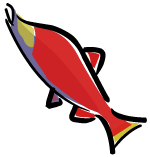
Alaska Salmon spawn in over 2,000 freshwater rivers and lakes across the state of Alaska. From there they migrate to the ocean, swimming thousands of miles through the Bering Sea and Gulf of Alaska, feeding on ocean krill, shrimp and other small fish. This natural diet, combined with the rigors of swimming through icy waters, gives Alaska Salmon their unique flavor, color and superior texture.
There are five unique and delicious species – Alaska King, Sockeye, Keta, Coho and Pink Salmon. Although the lifecycle and spawning characteristics of each of the five species differ, each maintains the same timing year after year, returning to the exact place of their birth.
Salmon do not eat once they have entered fresh water and they leave the ocean heavy with fats and nutrients nutrients to carry them through their rigorous journey upstream. It is at this point of peak quality, just before they reach fresh water, that the salmon are harvested in a FAO controlled sustainable manner.
The Lifecycle Of Alaska Salmon
- The small salmon eggs are hidden in nests, called redds.
- The salmon eggs incubate for five to seven months and hatch where the spawning pair deposited and fertilized the eggs the fall before.
- In spring the newly hatched salmon fry emerge from the gravel and begin their journey.
- Some species of salmon migrate directly down the rivers to the sea almost immediately, while others spend 1-3 years in freshwater rivers or lakes.
- When the fry do migrate toward the sea, they undergo certain changes, which prepare them for life in salt water, and during this stage of life it is called a smolt.
- In the estuary, where salt and fresh water mix and food is abundant, the smolt may double or even triple its weight before venturing westward into the Gulf of Alaska or Bering Sea.
- In the ocean the young salmon eat plankton and smaller fishes, while evading predators like birds, seals, whales, and other fishes.
- Alaska salmon travel thousands of miles. Depending on the species, salmon take 2-4 years to grow to adulthood in the cold rich waters of the North Pacific Ocean.
- In summer the instincts of the salmon lead their migration back to the Alaska streams in which they were hatched.
- The female salmon digs a nest in the cleanest part of the streambed and then selects a male to fertilize her eggs, as she deposits them in the gravel. All Alaska salmon die after spawning once in their lives.
It is easy to believe that a healthy fish is healthier to eat. To prove the point, there are multiple “seafood selector” reference guides published by non-profit and governmental organizations that provide detailed information on the quality of different seafood varieties. Two of these include the Environmental Defense Fund’s Seafood Selector and the Monterey Bay Aquarium Seafood Watch.




